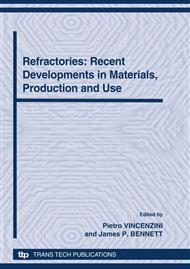[1]
He H, Palco S, Rigaud M, Extruded graphite pellets in magnesia-based castables. Canadian Metallurgical Quarterly, 2003, 42(2), 149-156.
DOI: 10.1179/cmq.2003.42.2.149
Google Scholar
[2]
Fangbao Y, Rigaud M, Xinhong L, Xiangchong Z. Rheology of alumina-based graphite-containing castables. China's refractories, Vol. 14, No. 1, 2005, 3-8.
Google Scholar
[3]
Yoshida A, Nemoto T, Kaneyasu A. Evaluation Method for Hydration Resistance of Magnesia Fine Powder and the Effect of B2O3 Contant on Magnesia Raw Materials. Proceedings of the UNITECR'03, 2003, Osaka, 433- 436.
Google Scholar
[4]
Kaneyasu A, Yamamoto S, Yoshida A. Magnesia Raw Materials with Improved Hydration Resistance. Taikabutsu Overseas. 1996 17(2), 21-26.
Google Scholar
[5]
Koga Y, Sato M, Sekiguchi K, Iwamoto Y. Effects of Alumina Cements Garde and Additives on Alumina-Magensia Castables Containing Aluminium Lactate. Taikabutsu Overseas. 1997 18(1), 43-47.
Google Scholar
[6]
Salomao R, Pandolfelli VC. Magnesia Sinter Dehydration Behaviour in Refractory Castables. Ceramics International, 2008, Vol. 43 (8), 1829-1834.
DOI: 10.1016/j.ceramint.2007.06.009
Google Scholar
[6]
Salomao R, Pandolfelli VC. Magnesia Anti-Hydration Techniques for Refractory Castables. Proceedings of the UNITECR'07, 2007, Dresden, 558- 561.
Google Scholar
[8]
Pagliosa C, Pandolfelli V C. R2U – Ready to Use Castables. American Ceramic Society Bulletin, Vol. 87, No. 1, (2008), 22-25.
Google Scholar
[9]
PCT/EP2007/056882.
Google Scholar
[10]
Jansen H, Dudczig S, Aneziris CG. Magnesia-Carbon Castable with New Properties. Proceedings of the 51st International Colloquium on Refractories, 2008, Aachen, 84 – 86.
Google Scholar
[11]
Aneziris CG, Dudczig S, Suren J, Stracke P. Oxide Castable based on a Novel Cement-, Phosphate and Nano Alumin/Silica- Free Binder System. Proceedings of the UNITECR'09, 2009, Salvador.
Google Scholar
[12]
Roungos V, Aneziris CG, Schärfl W. Mechanical, Physical and Thermomechanical Properties of Al2O3-C Refractories under Oxidizing atmospheres. Proceedings of the UNITECR'09, 2009, Salvador.
Google Scholar
[13]
Tamura S, Ochiai T, Takanaga S, Kanai T, Nakamura H. Nano-Tech. Refractories – 1 The Development of the Nano Structural Matrix, Proceedings of the UNITECR'03, 2003, Osaka, 517 – 520.
DOI: 10.1002/9781118837009.ch51
Google Scholar
[14]
Takanaga S, Ochiai T, Tamura S, Kanai T, Nakamura H. Nano-Tech. Refractories – 2 The Application of the Nano Structural Matrix to MgO-C bricks. Proceedings of the UNITECR'03, 2003, Osaka, 521 – 524.
DOI: 10.1002/9781118837009.ch51
Google Scholar
[15]
Zang S. Next Generation of carbon-containing refractory composite. Industrial Ceramics, 2007, 27 (1), 15 – 20.
Google Scholar
[16]
Marzban R, Nemati Z A, Otroj S, Sagadi N, The Influence of nano-alumina particles on the self-flow characteristics of alumina-spinel self-flowing castables, UNITECR 2007 Dresden, Germany, 532-535.
DOI: 10.1016/j.ceramint.2010.11.013
Google Scholar


